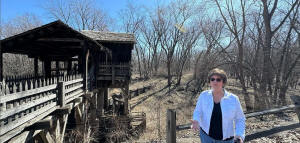After public pressure, Illinois commits $8M to repair deteriorating site
where Lincoln launched political career
[March 26, 2025]
By Athan Yanos, Erin Drumm
PETERSBURG — Nearly a century after the Civil Conservation Corps
reconstructed the once-thriving village of New Salem where Abraham
Lincoln spent his 20s working odd jobs, studying law and winning his
first election, the historic site just northwest of Springfield has
fallen into disrepair.
Lincoln’s New Salem State Historic Site is a replica of the hamlet where
Lincoln lived for six years during his early adulthood, and where he won
his first elective office – though only after losing his first election.
For decades, it’s been a destination for school field trips and tourists
visiting Springfield to immerse themselves in the 16th president’s
adopted hometown.
But these days, the roofs on three of the site’s structures are caving
in.
The Carding Mill, a replica of the original machine at the site that
spun wool into fabric and the only animal-powered one of its kind in the
United States, is at risk of being irreparably damaged. Last month, a
big section of the mill’s roof “totally collapsed” onto the wheel that
would have been rotated by oxen.
In fact, many of the two-dozen buildings on the site are deteriorating,
according to Gina Gillmore-Wolter, president of the New Salem Lincoln
League, a volunteer organization that puts on events and tours at the
site. In addition to moss, saplings are sprouting from rooftops while
rot and mold are spreading inside the buildings, which was evident on a
recent media tour of New Salem.
”It’s no exaggeration when we say without swift intervention, we risk
losing these historical assets,” Gillmore-Wolter said at a Capitol news
conference last month.

New Salem includes 23 historical replicas, including homes, barns,
stores, a tavern, school, and three mills for wool, lumber and wheat.
The site also has a visitor center with museum exhibits and an
auditorium, plus an outdoor theater and acres of hiking trails, a
campground and playground.
Prompted by Gillmore-Wolter’s efforts, a pair of Republican state
lawmakers are seeking a fix for New Salem via a package of legislation
introduced last month to prioritize and fund repairs. The trio of bills,
which have bipartisan support, initially sought to spend $5 million from
the state’s infrastructure fund.
But state Sen. Steve McClure, R-Springfield, said that after the
Illinois Department of Natural Resources informed him that it would take
$19 million to fully repair the site, he intended to amend his
legislative funding request accordingly.
However, IDNR beat McClure to it last week, announcing in tandem with
the state’s Capital Development Board that it would spend $8 million to
repair “up to 23 log village buildings and update the outdoor theater”
at New Salem.
“For decades, Illinois families have enjoyed visiting New Salem for
class trips, historical demonstrations, scouting excursions, theater
outings, candlelight walks, summer picnics, and more,” IDNR Director
Natalie Phelps Finnie said in the news release announcing the funding.
“We want to ensure visitors can continue enjoying all that New Salem has
to offer for years to come.”
Deferred maintenance
Despite New Salem’s deteriorating condition, the crumbling roofs and
general rot of the buildings don’t even make IDNR’s list of top five
deferred maintenance projects, according to agency spokesperson Jayette
Bolinski. The $19 million in estimated repair needs at New Salem
represent less than 2% of the agency’s total $1 billion deferred
maintenance bill for properties statewide ranging from other state
historic sites to critical water infrastructure.
In the last eight years, IDNR has spent $2.8 million at New Salem on
projects as banal as HVAC repairs and replacements to expensive
endeavors like building new bathrooms at the site’s concession center,
reconstructing a barn on site and repairing a covered bridge.
State Rep. Wayne Rosenthal, R-Morrisonville, who intends to carry
McClure’s bills in the House, said the list of necessary repairs at New
Salem wouldn’t be so expensive had IDNR received adequate funding from
the state to repair damages when they happened instead of letting them
linger.

“Normal maintenance becomes deferred maintenance when you don’t have the
resources to pay for it or the people to do the work,” he said. “And
deferred maintenance becomes deterioration.”
Rosenthal served as IDNR director from 2015 to 2019, including during
the state’s two-year budget impasse under former Gov. Bruce Rauner. But
he pointed to ex-Gov. Rod Blagojevich’s administration as the beginning
of a series of budget cuts that severely limited the agency’s ability to
maintain historic sites and national parks like New Salem.
”At one time we had probably close to 3,000 personnel and now they’re
down to probably 1,200, so when you lose that much manpower, it makes a
world of difference on everything,” Rep. Rosenthal said.
According to Bolinski, IDNR had approximately 2,400 employees in the
late 1990s, but when Gov. JB Pritzker took office in early 2019, agency
payroll had shrunk to 1,140. IDNR continued getting smaller even as the
agency was tasked with more responsibilities in the years that followed
its transformation from the hunting and fishing-focused Department of
Conservation in 1995.
While Rosenthal was serving as IDNR director in 2017, responsibility for
the state’s 56 historic sites was also transferred to the agency’s
purview after the Illinois Historic Preservation Agency was dissolved
into it.
In the last six years, the Pritzker administration has added a modest
number of staffers to IDNR; according to Bolinski, agency headcount
currently stands at 1,245.
[to top of second column]
|

New Salem Lincoln League President Gina Gillmore-Wolter stands in
front of the Grist Mill at the New Salem Historic Site on March 10,
2025. The mill’s drive shaft has been lying in the weeds near the
structure since 2016 after it was dislodged due to flooding. (Medill
Illinois News Bureau photo by Athan Yanos)

Only seven IDNR employees are dedicated full-time to New Salem. One of
those staffers is a carpenter, though he generally works on smaller
projects like repairing picnic tables and fences. According to Bolinski,
the agency is authorized to hire a construction company to do repairs –
but only if IDNR has the funds. And for construction projects that
exceed $350,000, the project must go through approvals from the Capital
Development Board, likely involving organized labor.
But McClure and Rosenthal are pushing for legislation to waive normal
state procurement rules for repairs on New Salem so the state can more
easily find and contract with skilled tradesmen who are capable of
construction techniques true to the era in which the village was built.
One of the larger needed repairs at the site includes the Grist Mill, a
replica of the mill where New Salem residents would grind wheat into
flour. The mill’s drive shaft has been lying in the weeds near the
structure since 2016 after it was dislodged due to flooding.
Gillmore-Wolter, who grew up visiting the site as a child, said she
doesn’t recall the last time the Grist Mill was operable but is eager to
see it repaired.
“ I think this would be top on the priority list of repairs,” she said,
citing the mill’s importance not just to New Salem but to the local
economy. “ It brought tourists out here. They would go on into
Petersburg and eat lunch and buy gas.”
Gillmore-Wolter estimated New Salem used to draw upwards of 400,000
people a year as school buses dropped off students on field trips and
visitors from across the world traveled to central Illinois.
Gillmore-Wolter said that because of the decay at the site, its
popularity has dwindled significantly, though IDNR’s official visitor
count for 2024 was 359,950.
In addition to setting aside funds for repairs at New Salem and
suspending procurement requirements, one of McClure and Rosenthal’s
proposed bills would also create a dedicated 13-member commission to
oversee New Salem, which they said is necessary to make recommendations,
develop plans and coordinate repair and maintenance efforts.
All three legislative proposals have already picked up Democratic
co-sponsors but the commission bill passed through a Senate committee
last month.

However, IDNR is not supportive of the idea, panning it as merely
“creating additional bureaucracy and red tape.”
Instead, the agency encouraged Gillmore-Wolter’s group, the New Salem
Lincoln League to accept its offer of re-entering into a “Friends”
agreement, which include memorandums of understanding between IDNR and
nonprofits with vested interest in a particular state property. The MOU
outlines rights and responsibilities of both parties – including
financially. The league’s previous MOU has been expired since the end of
2022.
“Historic sites Friends groups and advocacy groups have been able to
work well with IDNR on site improvements for years,” the agency said.
Lincoln in New Salem
When Lincoln arrived in New Salem in 1831, the village was new, having
only been settled two years prior. During his six years there, the
future president held a series of jobs, including as postmaster, running
a general store-turned-tavern and picking up side work harvesting crops,
helping at the mill and splitting rails – a task that would later
inspire the nickname “railsplitter” decades later as Lincoln ran for
president.
Lincoln began cutting his political teeth soon after moving to New
Salem, working the polls the day of the 1831 congressional election,
which allowed him to meet most of the men in town, whom Gillmore-Wolter
said were key to his development.
“The residents of New Salem really recognized his potential for
leadership, his ingenuity, and they really fostered that in him,” she
said. “For example, some residents would bring him books to read from
Illinois College.”
In 1832, Lincoln was elected captain by his company in the state militia
during the Black Hawk War, but he also experienced his first electoral
loss that same year in a failed bid for a seat in the Illinois House.
Two years later, however, he was elected state representative, a post
he’d hold through his move to Springfield. Not long after Lincoln’s
departure from New Salem, the town was abandoned and left to pasture.
“ If it wasn’t for New Salem, President Lincoln would not be in the
state of Illinois, and he would have never run for office, potentially,”
McClure said.
State Sen. Robert Peters, D-Chicago, who signed on as co-sponsor of the
New Salem commission bill, also emphasized the site’s significance.
“This legislation not only safeguards a key part of our state’s heritage
but also guarantees the story of Abraham Lincoln’s early life will
continue to inspire and educate for years to come,” he said in a
statement.
Erin Drumm and Athan Yanos are graduate students in
journalism with Northwestern University’s Medill School of
Journalism, Media, Integrated Marketing Communications, and fellows
in its Medill Illinois News Bureau working in partnership with
Capitol News Illinois.
Capitol News Illinois is
a nonprofit, nonpartisan news service that distributes state
government coverage to hundreds of news outlets statewide. It is
funded primarily by the Illinois Press Foundation and the Robert R.
McCormick Foundation. |